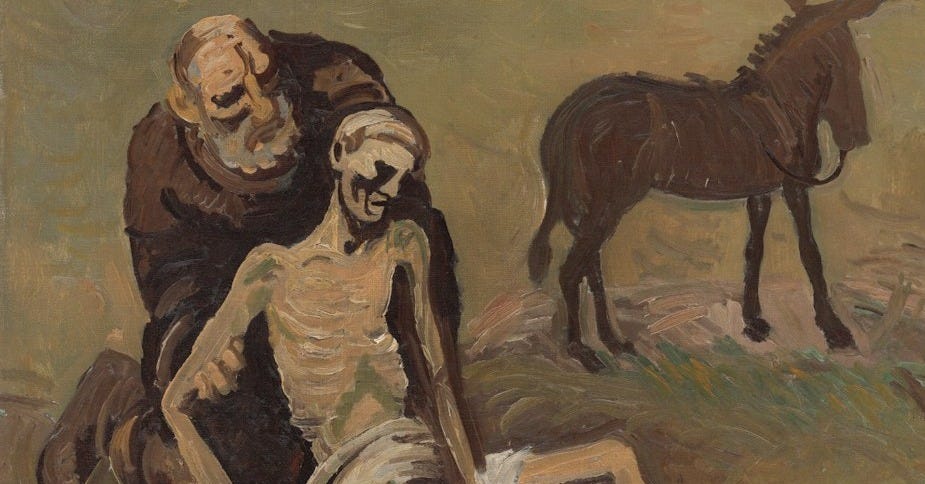Either / Or?
Exploring the deep layers of Scripture—where moral challenge meets spiritual mystery.
There’s a pattern I’ve noticed in how we talk about the Bible—especially when it comes to interpreting parables. We tend to apply only an either/or option. Was this meant literally or figuratively? Is this passage giving us moral instruction or theological meaning? It's a habit most of us picked up without realizing it, but it shapes how we hear Jesus.
In fact, the either/or approach to Bible reading can actually shrink the beauty and power of Holy Scripture.
The parable of the Good Samaritan
It’s one of Jesus’s most familiar stories. A man is attacked, left for dead, and the ones you'd expect to help—religious insiders—pass him by. Then along comes a Samaritan, someone from a group despised by the original audience, and he is the one who stops, tends the wounds, and carries the man to safety.
We often read that story as a moral challenge. And rightly so. It’s a clear call to love our neighbor, to show mercy, and to allow compassion to cross the boundaries of tribe, race, and religion. It’s not a complicated interpretation—but it’s deeply convicting.
Early Christian thinkers saw something more going on.
People like Augustine read the parable allegorically. They saw the wounded man as humanity itself—left broken by sin. The Samaritan? Christ. The oil and wine? Signs of healing grace. The inn is the Church, the place where the wounded are cared for. Even the Samaritan’s promise to return is a hint at the Second Coming.
Does His allegorical reading cancel out the moral one? No, It completes it.
Jesus isn’t just saying, “Go be nice.” He’s also saying, “This is what I’ve done for you.” The one left for dead isn’t just someone you’re called to help—it’s also you. And Christ has been the unlikely Savior who picked you up and carried you when others passed you by.
Recently I’ve come to believe that we’re not meant to pick between the literal and the figurative in stories like this. I think we’re supposed to hold them together.
Because sometimes, the most faithful reading of Scripture is one that honors both the moral and the mystical. It moves us to action and draws us into awe. The Bible often resists simple categories—it speaks in layers. Not confusion, but richness. Augustine understood the Bible as divinely designed, not limited to one plain meaning but overflowing with spiritual insight.
Why Does Augustine’s Both/And Bible Reading Matter?
Using his method of reading Scripture invites us to:
- See Christ in all of Scripture
- Read not just with intellect, but with faith and imagination
- Trust that God speaks to us layer by layer, as we grow
I invite you to revisit the parable with this dual lens in mind, spend some time with Luke 10:25–37. These questions will help you read it as layered truth:
· What are the elements in the story?
· What question does the Parable literally answer?
· What does it teach you morally?
· Where do you see Christ in the story?
· How does this parable give you hope for the world to come?
Jesus responds to a question about inheriting eternal life and ends telling us to “go and do likewise.” Somewhere in between, we find ourselves to be both the one who needs saving and the one being called to show mercy.
So, the next time we read a parable, instead of asking “Is this story literal or figurative?” Let’s ask, “Why can’t both be true on different levels?”
Closing Note:
When I heard the Good Samaritan parable was the text for the sermon that Sunday my first instinct was to hope for a homily more informed by current events than Scripture, because I knew that is what I would have done. But I was disappointed because our preacher refused to use it as a pretext to talk about current political events and, as if that wasn’t bad enough, he even had the audacity to throw Augustine’s allegorical interpretation in the mix. After the service I told him how disappointed I was and why. Gracious as always, he agreed to meet with me during the week., To prepare I did the unthinkable, I actually read Augustine’s own reason for applying allegory to this parable without denying its literal meaning. Study, always a dangerous pursuit, set me thinking more deeply about Scripture. I realized there’s more being said than I allowed myself to hear. That was the genesis of this post.
So, by the time we met all I could do was apologize for being THAT guy (those in ministry know who I mean). I’m grateful for the man of God and his sermon that pushed me deeper into Scripture—and back into the wonder of the Word of God.



Tim thanks for your post - good insights. I love studying Jesus’ Parables. One of my favorite authors/theologians to read on parables is Kenneth E. Bailey - he provides a historical and cultural perspective on them. Some good titles are: Through Peasants Eyes, Poet and Peasant, & Finding the Lost Cultural Keys to Luke 15. Blessings, Mark